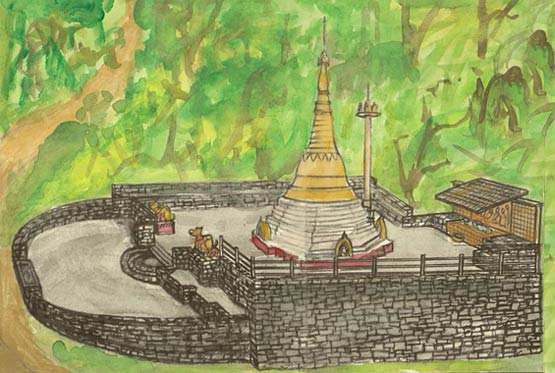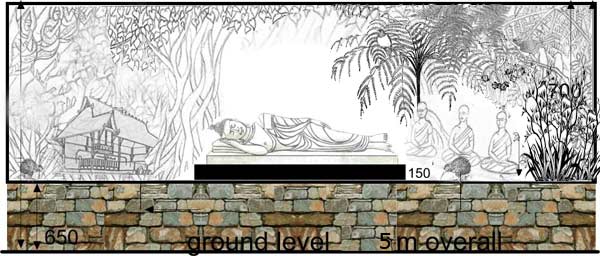Stupa Upgrade & Extension
Progress…
December 2017 —
The forecourt stonework is complete and the digger has leveled the area and generally landscaped around the road and entrance. The new court has been surfaced with plain gravel – similar to the cloister courtyard. This will allow time for new soil to compact and for us all to give thought to various future options. There is no hurry. The good news is that the stones from Sri Lanka are complete and have been shipped: 13.12.2017. All going well they will be here late-January. We are not sure if we will take them directly to the site or leave them on view in the lower courtyard.
The west-side is slowly moving forward. Work on the white marble reclining Buddha rupa in Thailand is well underway and we hope to get pictures soon. A change of scale has it now raised on a granite plinth (see sketch below). The design for the terracotta mural, also from Thailand, has still not been finalized but several changes have been made and we are much happier with the current layout. It now extends full width with an ’empty’ central space behind the rupa. Construction work on the stone base and concrete block back wall will begin soon.
The budget is being challenged but we are keeping up. Several elements have been sponsored either by groups or individuals and many people have made very generous donations. We very much appreciate everyone’s support and are confident that the result will be a beautiful, sacred space for many generations to come.
The Original Plan

At nearly 20 years old the stupa is showing signs of age and, to some degree, neglect. There are two main areas that could do with a lift.
The front…
This is currently the road which is badly rutted and runs very close to the entrance. The thought is to shift this to curve much wider away from the existing entrance. The space created can be fairly easily levelled to form a forecourt. A key fixture here would be a sandakada pahana – Sri Lankan moonstone – set at the base of the entry steps. The primary symbolism is the cycle of Samsara; lit. ‘world’ or ‘wandering’ – the wheel of birth and death. The symbolic elements are quite standard with a central half lotus, depicting the final goal, nibbana. This is enclosed by several concentric bands. The first is decorated with a procession of swans (the distinction between good and bad), followed by a band with an intricate foliage design known as liyavel symbolising worldly desires (tanha). The third band has a repeated sequence of four animals; elephants, lions, horses, and bulls symbolising the four stages in life: growth, energy, power and forbearance (or birth, aging, sickness and death). The fourth and outermost band is of flames, representing the fire of purification.
Other symbolic elements, such as the fronts of the stairs, could be added. The first step is to locate a skilled craftsman in Sri Lanka. With a very traditional design the process of detailing is made much simpler which will involve much less deliberation.
There is also thought to have a small noticeboard giving some detail of the meaning and function of the stupa.

There are early drawings from the mid-nineties showing various options for this segment but the work was never done. The current plan is a parinibbana (the final passing) buddha statue from Thailand housed in ‘some kind of pavilion.’
The earlier sketch (above) was generally agreed to be a bit ‘heavy’ and ornate. After much discussion with monks, committee and visitors various parameters became clearer. An on-site meeting with Hugh Tennent (architect) and others saw details gel quite nicely and the sketch (adjacent) was Hugh’s distillation of the many factors. There are still some finer points to resolve but the concept seems agreeable to many. An outline of the earlier parameters has been left below. The added element is the terracotta mural behind the rupa.

